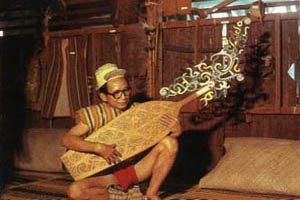|
|
|||||||||||||||||||||||||||||||||||||||||||||||||||||||||||||||||||||||||||
|
|
|||||||||||||||||||||||||||||||||||||||||||||||||||||||||||||||||||||||||||

|
|||||||||||||||||||||||||||||||||||||||||||||||||||||||||||||||||||||||||||
|
OMEGA CARVINGS Most of Sarawak's indigenous people are skilled woodcarvers. The Iban produce ornate carved hornbills for Gawai Kenyalang (The Hornbill Festival), and the Melanau carve intricate sickness figures for use in healing rituals. But the best known of Sarawak's woodcarvers are the Orang Ulu, particularly the Kayan and Kenyah. Their longhouses are decorated with beautifully carved panels and detailing, and even their musical instruments, such as the mandolin-like sape, are works of art. Among the Kayan and Kenyah natives, doorways to the chiefs and aristocratic families were enhanced with carvings and paintings, both to denote status as well as to repel malevolent spirits. They are most famous, however, for their superb figurative works, their intricate wildlife carvings and the aso, a ferocious dog-like ancestor spirit.
BLOWPIPES Most of Sarawak's native groups have used the blowpipe (blowgun) in the past. A blowpipe is first made out of a piece of strait-grained wood, roughly shaped to about 2 meters and a diameter of 15 cm. Then it is wedged in an upright position within a platform built around it. The weapon is perforated by means of a long metal rod with a chisel shaped bit. The rod is moved on its own axis, back and forth, with the bit slowly drilling into the wood. From time to time, water is poured into the hole to float out wood chips. When the drilling has been completed, the pipe is trimmed and whittled to a diameter of about 5-cm. The finished weapon is polished with a tough- grained, slightly waxy leaf. The bore of the blowpipe is very slightly curved to compensate for the weight of the weapon in use as it is horizontally held. The customary double-edged spear blade lashed to the muzzle end, which makes a serviceable pike out of the blowpipe, also adds weight. The bore is polished by means of pulling lengths of rattan through it. CARVED PADDLES Young Orang Ulu men used to carve paddles for their own use or for the lady of their heart. Longhouses were always near watercourses since the river was the easiest and most common way of communication. Some people might not know how to swim, but they could always paddle. Although the big longboat often belonged to rich aristocrats or to the community, and a family or an individual, but everybody who owned the smaller dugouts had his or her own paddle. Well-carved paddles are used for ceremonial occasions. It is not only used to show off their carving skills but also their status among the villagers. BAMBOO CONTAINERS Borneo natives use bamboo containers to keep their important documents. The containers are decorated with all kinds of intricate patterns, depending on the inclination of the artist. Bamboo is a light material and when carved is beautiful and useful both for storing small objects and souvenirs. HORNBILL ICONS The most famous Iban native carving is the Kenyalang; the hornbill effigy made for an elaborate festival celebrating outstanding achievement. The real hornbill's basic outline is realistically observed; the bird has a disproportionately long, heavy beak, a squat body, and straight tail feathers almost as long as the body. The carved kenyalang's head and beak stretch forward, while the head is represented by scrollwork. The body portion is solid, to balance the two extremities. The tail is covered with decorations either of a symbolic or a very realistic kind. The whole piece is embellished with oil paint in many colors of the rainbow. WOODEN CARVED MASKS Sarawak masks were traditionally used to frighten naughty children. An older woman whose immediate family has no young children usually wore the masks to tease other children in her neighborhood. Most masks have an open mouth with great emphasis usually given to the teeth. SAPE One of the most popular musical instruments in Sarawak is the 'sape'. This guitar like instrument is carved from a tree trunk in an elongated rectangular shape with a homogeneous neck extending from one end of the body. The topside of the long arrow body is frequently decorated with carved motifs. The backside is hollow and usually left open. The 'sape' usually has two wire strings which are attached near the base end of the body. The two strings pass over a small bridge near the base and extend the full length of the body and neck where they are fastened to the tuning pegs near the head of the instrument. CARVED HUMAN FIGURES Wooden carved human figures usually come in different forms and sizes. These carvings portray different traditional activities often associated with long house life; such as dancing warrior, blowpipe man, and native woman carrying baby. Sarawak's wooden bowls are often carved with the image of a hornbill or the dragon-dog (aso). Aso is a combined image of a dragon and dog with a reptile body. It is the most distinctive of all Borneo motifs. It has protuberant eyes and its mouth, which is usually studded with teeth, is always open, its jaws and fans curling upwards and downwards. The aso shows the dragon's features more than the dog's, with wide staring eyes and angular head. SHIELDS The village warriors used shields to defend and guard the long houses in the villages traditionally. Today, during ceremonial dances, young warriors use these shields to enact legends of the past. Webmaster: Functionet Management Services / E-mail: functionet@hotmail.com Copyright © 1996 [Functionet Management Services]. All rights reserved. Last Updated: April 24, 2000. |

|
||||||||||||||||||||||||||||||||||||||||||||||||||||||||||||||||||||||||||

|
|||||||||||||||||||||||||||||||||||||||||||||||||||||||||||||||||||||||||||

|
|||||||||||||||||||||||||||||||||||||||||||||||||||||||||||||||||||||||||||
|
|||||||||||||||||||||||||||||||||||||||||||||||||||||||||||||||||||||||||||
|
|||||||||||||||||||||||||||||||||||||||||||||||||||||||||||||||||||||||||||